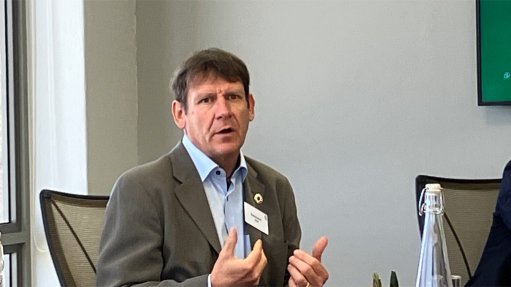Close collaboration essential to ensure competitive market, industry
Global growth is expected to be subdued, if not stagnant, in 2024, and amid this slow growth and some challenging market conditions, global trade is also expected to be sluggish, says financial services company Investec logistics head Denys Hobson, who references the World Bank’s estimation that in 2024, global trade growth is anticipated to be only half the average of that for the decade before the pandemic.
“We expect this year to be quite volatile,” he says, noting that inflation, globally, has been coming down and the market consensus is for interest rates cuts to come into effect later in the year, while gross domestic product growth is still muted.
Additionally, current geopolitical tensions are high, though Hobson mentions that while these tensions currently only have a direct effect on certain regional trade routes such as Europe-Asia, should they escalate, “it certainly can destabilise global trade and supply chains in many ways”.
As an example, he refers to the recent military strikes in the Red Sea, which have resulted in sea freight cargo being delayed in transit and impacted companies having to, subsequently, airfreight additional stock in to compensate for the sea freight delays.
This pushes up the demand for airfreight and with an increase in demand, the airfreight rates also increase, which also leads to higher landed costs.
Hobson notes that sea freight costs also increase on trades impacted by the current Red Sea situation because shipping lines have diverted their vessels around the Cape of Good Hope, which increases transit times and costs, as well as reducing their capacity and equipment availability.
“It is also an election year for more than 50 countries this year and we know that with this, it can create uncertainty in various forms such as investments and policy, but it also can bring about positive sentiment depending on the respective outcomes,” he comments.
He also mentions that weather patterns are becoming more volatile and extreme, and that these can have the ability to impact global capacity and routes.
“One just has to examine the recent drought in Panama to see the impact of climate change on global trade. If we start to get significant increases in weather events for extended periods of time, we may experience disruptions to supply chains,” he comments.
Meanwhile, from a South African perspective, Hobson says the biggest concern is the efficiency of ports and rail infrastructure.
“If sustainable progress doesn’t [occur] soon, we may see further route and capacity changes on the South African in- and outbound routes as it has become too expensive to have vessels stuck in ports for days and weeks,” he notes, noting that shipping lines could use their capacity more effectively on other trades if required.
“We may even see some remove direct sailings or only have limited sailings coming into South Africa, which will reduce available capacity and increase freight rates,” he adds.
Additionally, the South African rand is also expected to remain under pressure and with ongoing concerns around State-owned entity Transnet and loadshedding, investor confidence remains muted.
While much is under way at Transnet to improve performance across multiple areas, Investec does not expect rail to operate efficiently this year and believes that it is likely still going to be a hindrance to the industry and South Africa’s economic growth.
“To get it where it needs to be, with tangible change, it is going to require substantial collaboration across private and government sectors as rail and ports need to work together to achieve meaningful change and progress. This of course will require clear policies, transparency, investment, and decisive leadership,” Hobson says.
Generally, however, given the last few years, Hobson is confident that South Africa should be able to adapt much quicker to supply chain shocks, as the country has been learning from the lessons of the past and been able to adjust to any disruptions.
However, he warns importers to be cautious, as they “need to watch their costs closely, adjust lead times where required and examine ways of ensuring that their working capital is effectively used”.
Financial discipline is key and market conditions will eventually become more buoyant, which will open additional avenues and opportunities for growth both locally and abroad, with companies urged to keep in shape “to be able to take advantage of these”, he suggests.
Article Enquiry
Email Article
Save Article
Feedback
To advertise email advertising@creamermedia.co.za or click here
Comments
Press Office
Announcements
What's On
Subscribe to improve your user experience...
Option 1 (equivalent of R125 a month):
Receive a weekly copy of Creamer Media's Engineering News & Mining Weekly magazine
(print copy for those in South Africa and e-magazine for those outside of South Africa)
Receive daily email newsletters
Access to full search results
Access archive of magazine back copies
Access to Projects in Progress
Access to ONE Research Report of your choice in PDF format
Option 2 (equivalent of R375 a month):
All benefits from Option 1
PLUS
Access to Creamer Media's Research Channel Africa for ALL Research Reports, in PDF format, on various industrial and mining sectors
including Electricity; Water; Energy Transition; Hydrogen; Roads, Rail and Ports; Coal; Gold; Platinum; Battery Metals; etc.
Already a subscriber?
Forgotten your password?
Receive weekly copy of Creamer Media's Engineering News & Mining Weekly magazine (print copy for those in South Africa and e-magazine for those outside of South Africa)
➕
Recieve daily email newsletters
➕
Access to full search results
➕
Access archive of magazine back copies
➕
Access to Projects in Progress
➕
Access to ONE Research Report of your choice in PDF format
RESEARCH CHANNEL AFRICA
R4500 (equivalent of R375 a month)
SUBSCRIBEAll benefits from Option 1
➕
Access to Creamer Media's Research Channel Africa for ALL Research Reports on various industrial and mining sectors, in PDF format, including on:
Electricity
➕
Water
➕
Energy Transition
➕
Hydrogen
➕
Roads, Rail and Ports
➕
Coal
➕
Gold
➕
Platinum
➕
Battery Metals
➕
etc.
Receive all benefits from Option 1 or Option 2 delivered to numerous people at your company
➕
Multiple User names and Passwords for simultaneous log-ins
➕
Intranet integration access to all in your organisation





















